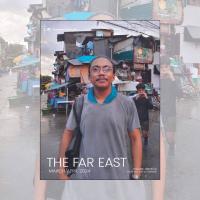A statue of The Beatles - Photo: Fr John Boles
Fr John Boles visits George Harrison’s old parish and finds the spirit of the “Fab Four” alive and well.
Columban supporters rarely become famous, but they just might know people who do. I recently had the good fortune to deliver an appeal on behalf of the Columbans at “Christ the King and Our Lady” in the Liverpool neighbourhood of Wavertree, England, a parish which has blessed us with many Columban benefactors. During the Second World War it was also the home parish of Harold and Louise Harrison. Harold worked as a ship’s steward on the transatlantic White Star Line, while Louise was an Irish shop assistant who loved to sing - to the point of “making the windows rattle”, so legend has it.
On 14 March 1943, Harold and Louise went to church to baptise the last of their four children. They gave the name “George” to their three-week-old baby boy.
Young George Harrison would go on to be lead guitarist in the world’s greatest-ever rock group - The Beatles. In a long and illustrious musical career, both with The Beatles and as a solo artist, he’d compose such classics as “Norwegian Wood”, “Here Comes the Sun”, “Something” and “While My Guitar Gently Weeps” before his untimely death from cancer in 2001 at the age of 58.
Robert Kidd works as the parish administrator and his family knew the Harrisons. He took me on my very own “Magical Mystery Tour”, first to the church of “Our Lady of Good Help” where George’s baptism took place. The church building is now sadly disused, but the primary school next door still functions. This is where Robert’s Auntie Eileen studied alongside George’s sister Louise.
Robert recalls how his aunt was never a great pop fan during the time of “Beatlemania”, whereas his Mum, Katherine, certainly was. “Probably one of those screaming girls!” he reflects. Next, we went round the corner to the Harrisons’ former residence. No. 12, Arnold Grove is a small, terraced house, which, in George’s day, was a “two-up, two-down” affair with a single coal fire, an outside toilet and a tiny backyard where the family kept chickens.
In 1950, the household moved to the district of Speke. George attended the local primary school where another pupil was a certain John Lennon. He then went on to study at the “Inny” - the Liverpool Institute - where he came across fellow music enthusiast Paul McCartney. By 1958 the three friends were in a group John had formed called The Quarrymen - George apparently having been auditioned on the top floor of a double-decker Liverpool bus. They changed to the “catchier” name of The Beatles two years later. When, in 1962, they acquired a new drummer - Richard (“Ringo Starr”) Starkey - and a new manager - Brian Epstein - the formula for global fame was well and truly established.
My wanderings down Fab Four memory lane took me from the parish of Wavertree over the boundary to Allerton, an area bursting with Beatles connections. On Menlove Avenue I paused to observe the house John Lennon had lived in from 1945 to 1963 with his Aunt Mimi and Uncle George. On Forthlin Rd I found the former McCartney family home where many early songs had been composed, including “She Loves You!”. Paul famously chose “Yeah, Yeah, Yeah”, a popular Americanism, for the chorus, overruling his dad Jim’s suggestion of standard English “Yes, Yes, Yes”.
Fr John Boles is Regional Director of St Columbans Mission Society in Britain.
Listen to "Rock-n-Roll Tongues of Fire"
Related links
- Read more from The Far East - November/December 2022


